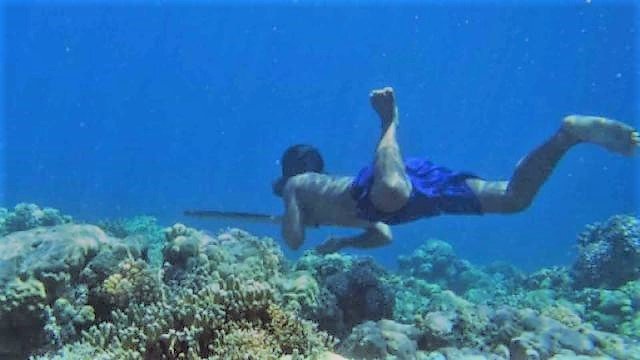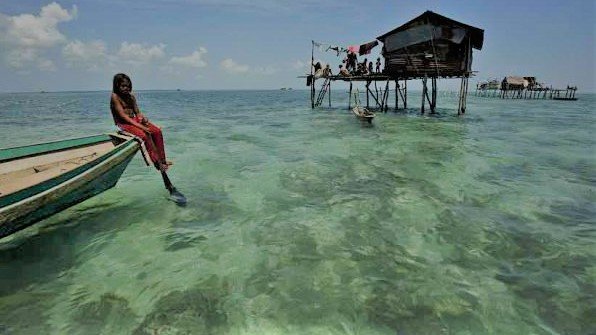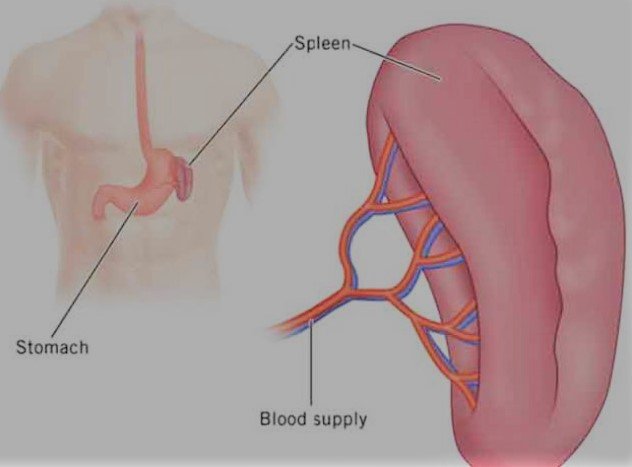Not imagined, they're really waterborne

In this way people gather in the water and collect food and collect food. Photo: AFP
They live in the water under 60 percent of the day. And this is affecting their evolution.
These people living in the Malay Archipelago, known as Bajao. Most of their lives are cut in the sea. In the shallow areas of the boat or on the coast, the makhagara is made. The whole population travels from one place to another in need of livelihood. Their diet relies on marine biodiversity. Bazoos spend 60 percent of their daily life under water.
They have the power to drown under the water. Occasionally 70 meters deep water can go and stay there for five minutes. They do not use much to go down the water. To prevent just flicking, one pair of heavy objects binds to the body and a glass of glass in front of a glass made of lenses. Such lenses are not so disturbed by the pressure of deep water.

As well as the boat, Bajoas thus live in the shallow areas of the coast of Makhaura. Photo: Reuters
As well as the boat, Bajoas thus live in the shallow areas of the coast of Makhaura. Photo: ReutersNokara as well as Bazoora thus resides in the shallow areas of the coast of Makhanpur. Photo: Reuters Bazood's survival history is so old. Historical documents show that their history of life is at least a thousand years old. Many researchers believe that Bazood's genetic traits adapted to their unique way of life. California University teacher Melissa Elarado and Rasmus Wellsen tried to identify the reason behind their strange behavior.
When a person drowns in water, then he has to keep on straining his technique. It is called 'diving response' or diver's reaction. Along with this there are several functions of the organism together. To save oxygen savings, reduce heart rate; Blood is transmitted to the highest oxygen-sensitive organs of the body, such as the brain, heart and lungs; The oxygen-rich red blood cells are essential to the contraction of the vital spleen, thus increasing the presence of these cells in the bloodstream. Mije Aldo and Nielsen Bazood decide to investigate whether genetic characteristics and physical constitution support these responses.
For this observation, Mies Eldoron went to Indonesia to appoint 59 Bajaoas, and in addition to collecting saliva for the DNA test, as well as measuring their spleen in the ultrasonic method. As a control group, he chose 34 of the Saluans. Although the Saluans live on the ground, close to Bajaj's neighbors. Ultrasic scans can be seen, Bajaod's splea is 50 percent larger than the spleen of the Saluans. This difference is a person who does not have a relationship with water in the water or in the boat. It indicates that it is not the work of diving in the water, but basically the genealogy is responsible for the big spleen.

Spleen Usually it acts as a blood filter.
Spleen Usually it acts as a blood filter. Generally, it acts as a blood filter. DNA analysis also gives evidence of the same phenomenon. In Bazood's genome, a transformation is detected, which controls the activity of a gene controlling blood flow. For example, oxygen-like blood is transmitted to the brain. Another feature is the transformation of carbonic anhydrase enzyme-producing genes. These enzymes slow the growth of carbon dioxide in the blood stream. This is due to the long Bajoyd's being in the water. The genes related to muscular contraction around the spleen are actually very much related to diving. By measuring spleen, oxygen can run blood in sensitive organs. Another change is noticed in Bazood's gene, which produces carbonic anhydrase. Such an enzyme was found in their bodies, which slowed down carbon dioxide production in the blood stream. Changes in the genetic modification of the muscles around the spleen, and the reaction against low oxygen also increases.
By combining these results, Mies Eldardo and Nielsen claimed that the practice of collecting food with dive brought this genetic change in Bazoids. But behind this evolution, the big family is not able to thrive in the water to feed enough food, or do their dying work while doing so, the mystery is not yet on the edge.
Hey @jessieberry, thanks for the update! I get most of my news updates from social media and such so it's nice to have great posts to stay informed. Keep up the good work! Cheers
Thank you for your continued support hiro!